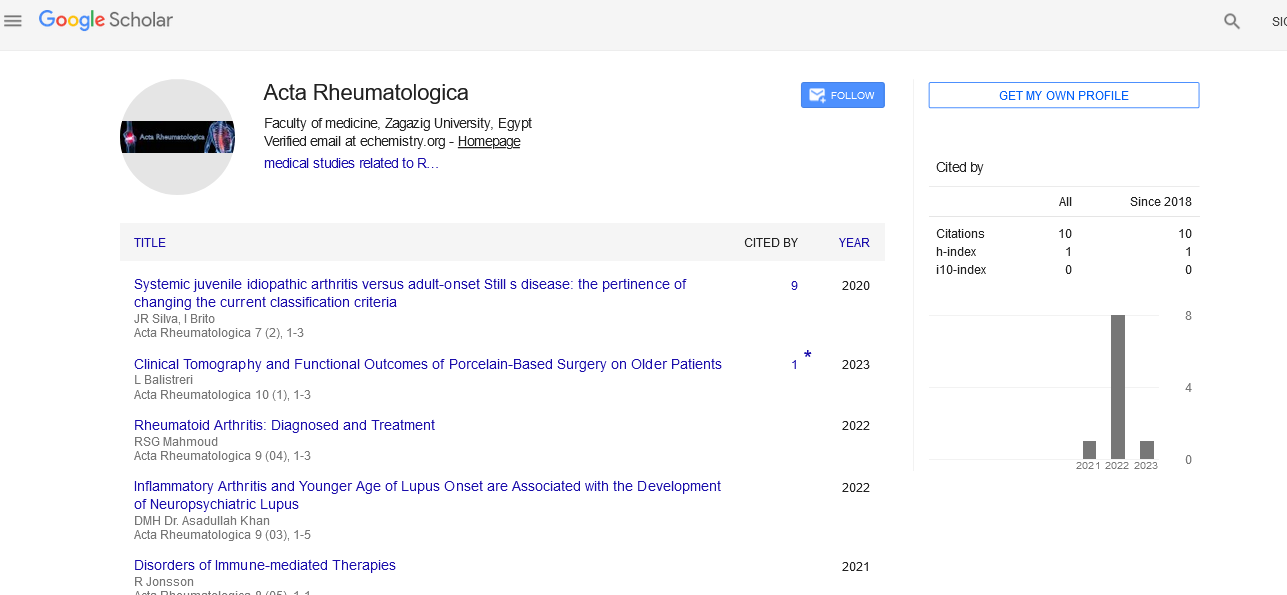Perspective - (2024) Volume 11, Issue 4
Diagnostic Imaging in Rheumatology: A Window into Joint Health
Uta Kiltz*
Department of Health Care, University of Munich, Munchen, Germany
*Correspondence:
Uta Kiltz, Department of Health Care, University of Munich, Munchen,
Germany,
Email:
Received: 08-Jul-2024, Manuscript No. IPAR-24-15053;
Editor assigned: 11-Jul-2024, Pre QC No. IPAR-24-15053 (PQ);
Reviewed: 25-Jul-2024, QC No. IPAR-24-15053;
Revised: 05-Aug-2024, Manuscript No. IPAR-24-15053 (R);
Published:
13-Aug-2024
Introduction
In the field of rheumatology, diagnostic imaging plays a pivotal
role in the comprehensive assessment and management of
various musculoskeletal conditions. From arthritis to systemic
autoimmune diseases, the ability to visualize and assess joint
structures and surrounding tissues is crucial for accurate
diagnosis and treatment planning. This article explores the
diverse array of imaging modalities utilized in rheumatology,
their specific applications, advancements in technology, and the
evolving role they play in enhancing patient care.
Introduction to diagnostic imaging in rheumatology
Rheumatology encompasses a broad spectrum of disorders
affecting joints, bones, muscles, and connective tissues. These
conditions often present with symptoms such as joint pain,
stiffness, swelling, and impaired function. While clinical
examination and laboratory tests are essential components of
diagnosis, diagnostic imaging provides clinicians with valuable
insights that are integral to confirming diagnoses, monitoring
disease progression, and evaluating treatment responses.
Description
Key imaging modalities
X-ray (Radiography): X-rays are one of the oldest and most
commonly used imaging modalities in rheumatology. They
provide detailed images of bones and can detect joint erosions,
narrowing of joint spaces, and changes in bone density
characteristic of conditions like osteoarthritis and Rheumatoid
Arthritis (RA). X-rays are particularly useful for assessing
structural damage over time.
Ultrasound (US): In recent years, musculoskeletal ultrasound
has gained prominence in rheumatology due to its portability,
cost-effectiveness, and ability to provide real-time images. It is
valuable for visualizing soft tissues, tendons, ligaments, and
synovial inflammation. US-guided procedures, such as joint
aspirations and injections, have become standard practice in
managing conditions like gout and inflammatory arthritis.
Magnetic Resonance Imaging (MRI): MRI offers unparalleled
soft tissue contrast and is highly sensitive in detecting early
inflammatory changes in joints. It is especially useful for
assessing synovitis, bone marrow edema, and cartilage damage
in diseases like axial spondyloarthritis and psoriatic arthritis.
Advances in MRI technology, including diffusion-weighted imaging
and dynamic contrast enhancement, continue to refine its
diagnostic utility.
Computed Tomography (CT): While less commonly used than
MRI in rheumatology, CT scans provide detailed images of bones
and can be particularly useful for evaluating complex fractures,
bone deformities, and in planning surgical interventions. CT is
also used in conjunction with Positron Emission Tomography
(PET-CT) for assessing systemic involvement in conditions like
vasculitis.
Emerging technologies and future directions
The field of diagnostic imaging in rheumatology is continuously
evolving with advancements in technology and methodologies:
Dual-Energy CT (DECT): Allows for improved characterization
of uric acid deposits in gout, aiding in more precise diagnosis
and treatment.
3D Imaging and virtual reality: Emerging techniques are
enabling three-dimensional reconstructions of joints and tissues,
facilitating enhanced surgical planning and patient education.
Artificial Intelligence (AI): AI-driven algorithms are being
developed to assist in interpreting imaging studies, improving
diagnostic accuracy, and predicting disease outcomes based on
radiographic features.
Clinical applications and challenges
While diagnostic imaging has revolutionized rheumatological
practice, several challenges persist:
Cost and accessibility: Advanced imaging modalities such as
MRI can be expensive and may not be readily available in all
healthcare settings.
Interpretation variability: Image interpretation requires
specialized training and expertise, leading to variability in
diagnostic accuracy among practitioners.
Radiation exposure: Despite advancements, X-rays and CT
scans involve ionizing radiation, necessitating judicious use to
minimize cumulative exposure risks.
Conclusion
Diagnostic imaging is indispensable in the field of
rheumatology, providing clinicians with critical information
essential for accurate diagnosis, treatment planning, and
monitoring disease progression. As technology continues to
advance, the role of imaging modalities will expand, offering
new insights into the pathophysiology of rheumatic diseases and
optimizing patient outcomes. However, challenges such as cost,
accessibility, and interpretation variability must be addressed to
ensure equitable and effective use across diverse patient
populations. By leveraging these technologies judiciously and
integrating them with clinical expertise, rheumatologists can
continue to enhance their ability to diagnose and manage
complex musculoskeletal conditions effectively.
Citation: Kiltz U (2024) Diagnostic Imaging in Rheumatology: A Window into Joint Health. Acta Rheuma Vol:11 No:4





